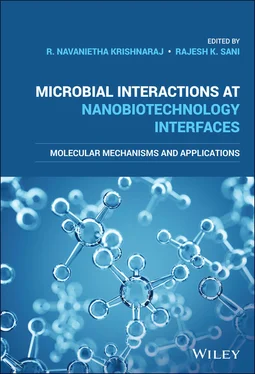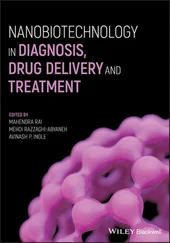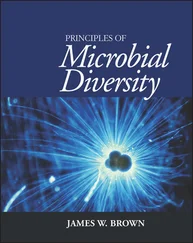Microbial Interactions at Nanobiotechnology Interfaces
Здесь есть возможность читать онлайн «Microbial Interactions at Nanobiotechnology Interfaces» — ознакомительный отрывок электронной книги совершенно бесплатно, а после прочтения отрывка купить полную версию. В некоторых случаях можно слушать аудио, скачать через торрент в формате fb2 и присутствует краткое содержание. Жанр: unrecognised, на английском языке. Описание произведения, (предисловие) а так же отзывы посетителей доступны на портале библиотеки ЛибКат.
- Название:Microbial Interactions at Nanobiotechnology Interfaces
- Автор:
- Жанр:
- Год:неизвестен
- ISBN:нет данных
- Рейтинг книги:4 / 5. Голосов: 1
-
Избранное:Добавить в избранное
- Отзывы:
-
Ваша оценка:
- 80
- 1
- 2
- 3
- 4
- 5
Microbial Interactions at Nanobiotechnology Interfaces: краткое содержание, описание и аннотация
Предлагаем к чтению аннотацию, описание, краткое содержание или предисловие (зависит от того, что написал сам автор книги «Microbial Interactions at Nanobiotechnology Interfaces»). Если вы не нашли необходимую информацию о книге — напишите в комментариях, мы постараемся отыскать её.
Microbial Interactions at Nanobiotechnology Interfaces — читать онлайн ознакомительный отрывок
Ниже представлен текст книги, разбитый по страницам. Система сохранения места последней прочитанной страницы, позволяет с удобством читать онлайн бесплатно книгу «Microbial Interactions at Nanobiotechnology Interfaces», без необходимости каждый раз заново искать на чём Вы остановились. Поставьте закладку, и сможете в любой момент перейти на страницу, на которой закончили чтение.
Интервал:
Закладка:
1.10.2 Shape
Next, to size, shape is also an important factor that affects the structural behavior and antimicrobial activity of the NMs. NMs of different shapes have shown to cause varying degrees of bacterial cell damage, mechanism of action, and antibacterial property (Cha et al., 2015). Hong et al. (2016) studied the antimicrobial property of sphere‐, wire‐, and cube‐shaped silver NPs of the same diameter. Notably, the nanoparticle with cubic shape exhibited the highest antimicrobial effect in comparison to other shapes. This was attributed to the specific facet reactivity and surface area of the cube‐shaped NPs (Hong et al., 2016). Another study was done to compare the enzyme inhibition and antimicrobial effects of the sphere‐, plate‐, and pyramid‐shaped nano‐ZnO particles. It was reported that the particles of pyramid shape showed a better β‐galactosidase enzyme inhibition and greater antimicrobial property. The system was a reversible inhibition system and worked by obstructing the enzyme similar to natural inhibitors unlike by the degradation of enzymes as reported earlier (Cha et al., 2015). In another study involving Y 2O 3NPs, the particles of prismatic shape showed better antibacterial activity against Pseudomonas desmolyticum and S. aureus . The antimicrobial activity was due to the direct interaction of prismatic‐shaped particles with cell membrane followed by the membrane damage and bacterial kill (Prasannakumar et al., 2015).
1.10.3 Zeta Potential
In addition to size and shape, zeta potential (surface charge) of the NMs is also known to affect the behavior of NMs. It is clear from the literature that the surface charge of the NMs has a strong influence on the adhesion of bacteria. Since bacterial cell surface is negatively charged, NMs with positive charge exert electrostatic attraction, which helps in the adsorption of bacteria onto the surface. This is the reason behind the enhanced ROS production by positively charged NM in comparison to neutral and negatively charged NMs. However, negatively charged NMs exhibit antimicrobial property at a higher concentration through molecular crowding leading to the interaction of NM surface with bacteria.
Pan et al. (2013) studied the antibacterial activity of Mg(OH) 2prepared using different precursors (MgCl 2, MgO, and MgSO 4). It has been reported that positively charged Mg(OH) 2NPs prepared with MgCl 2exhibited greater antimicrobial property against E. coli in comparison to negatively charged particles prepared with MgO. This was due to electrostatic interaction between the positively charged Mg(OH) 2with the negatively charged bacterial cell membrane resulting in damage to bacterial cell (Pan et al., 2013).
1.10.4 Roughness
Although majority of the studies were done by analyzing the effect of size, shape, and surface charge of NMs on their activity, a few studies have been performed to understand the effect of roughness. In one of them, Sukhorukova et al. (2015) prepared silver ion‐doped titanium calcium phosphate films. Here, it was found that the surface with high roughness promoted the retention E. coli bacteria onto the surface (Sukhorukova et al., 2015). Longer retention time enhanced antibacterial property of the films with higher roughness.
1.10.5 Synthesis Methods and Stabilizing Agents
The choice of synthesis methods and stabilizing agents is very crucial in the fabrication of antimicrobial NMs, since these factors also can influence the properties of the NMs to a major extent. As stated, during synthesis, NMs are synthesized by different methods such as laser ablation, mechanical milling, chemical etching, melt mixing, sputtering, and other chemical methods such as thermolysis, microemulsion, and sol–gel. However, the NMs that are synthesized through the chemical or physical methods are unstable, have surface‐attached toxic materials, and are formed along with toxic by‐products. Considering Ag NPs' synthesis, the process involves a reducing agent such as sodium borohydride or sodium citrate with capping agent such as polyethyl glycol. On the other hand, the biological synthesis methods employ biological sources such as microorganisms and plants. In the case of microbial biosynthesis, the microbes exert a bio‐reduction process to reduce and accumulate the metallic ions to avoid the metal‐related toxicity. The mechanism involves the reduction of metal ions inside the cell through intracellular reducing species and outside using their different extracellular metabolites. Plants also contain a number of reducing agents such as proteins, flavonoids, and other water‐soluble biomolecules (Singh et al., 2018). Green synthesis methods improve the stability of NMs with no hazardous by‐products. Further, they provide a biocompatible coating over NMs, which not only improves the biocompatibility but also increases surface area with reactive groups, which can improve the interaction with biological environment (Singh, Garg, Pandit, Mokkapati, & Mijakovic, 2018). For example, Sudhasree et al. (2014) showed that nickel NPs prepared from Desmodium gangeticum were monodispersed. The green synthesized NPs were found to possess high antibacterial activity against Klebsiella pneumonia, Pseudomonas aeruginosa, and Proteus vulgaris whereas the chemically synthesized nickel NPs had the least effect on the same microbes. Apart from enhancing the antimicrobial property, it also improved the biocompatibility as observed from biocompatibility studies using LLC PK1 (epithelial cell lines) (Sudhasree et al., 2014). However, the choice of a particular synthesis method depends on the nature of NM required and the type of applications.
Antimicrobial property is directly proportional to the surface area, surface charge, and the extent of interaction or contact of NMs with bacterial cell. In this regard, understanding the effect of stabilizing agents on NMs is also important. The stabilizing agents reduce agglomeration and provide net charge over NMs. Hence, these stabilizing agents to an extent determine the toxicity or antimicrobial property of the NMs. It was observed from a past study that the Ag NPs stabilized with chitosan and citrate enhanced the antimicrobial property of Ag NPs against multidrug‐resistant bacteria ( S. aureus and K. pneumonia ). The study also showed that effect of stabilizing agents chitosan and citrate over the microbes was at basal level (Cavassin et al., 2015). Similarly, Ag NPs coated with 11‐mercaptoundecanoic acid exhibited higher toxicity over P. aeruginosa in comparison to Ag NPs coated with citrate. Citrate capping provides net negative charge to the Ag NPs, which results in electrostatic repulsion between negatively charged bacterial cell and Ag NPs. In the case of 11‐mercaptoundecanoic acid capped Ag NPS, the particles agglomerated over the surface of the hydrophilic P. aeruginosa, which facilitated the release of Ag +ions near the proximity of cell and improved the toxicity of the NPs toward the bacteria (Dorobantu et al., 2015). In another study, El Badawy et al. (2010) studied the toxicity of Ag NPs coated with different capping agents such as citrate, polyvinylpyrrolidone, and branched polyethyleneimine. The coating provided Ag NPs with a range of surface charge from highly negative to highly positive. Among the different coatings, citrate coating showed the least toxicity against Bacillus species. The surface potential of the citrate capped Ag NPs was found to be −38 mV, which was in line with the surface charge of Bacillus species (−37 mV). The electrostatic repulsion between the negatively charged citrate capped Ag NPs and bacteria was the probable reason for the least toxic effect of citrate capped NPs. In accordance with that, highly positively charged branched polyethyleneimine‐coated Ag NPs (+40 mV) showed the highest toxicity whereas uncoated Ag NPs (−22 mV) and polyvinylpyrrolidone‐coated Ag NPs (−10 mV) exerted toxicity above the citrate capped Ag NPs (El Badawy et al., 2010). This clearly reveals that the nature and the structure of stabilizing agents affect the toxicity and the bactericidal potential of the NMs, which should be taken into account while fabricating NMs for antimicrobial properties.
Читать дальшеИнтервал:
Закладка:
Похожие книги на «Microbial Interactions at Nanobiotechnology Interfaces»
Представляем Вашему вниманию похожие книги на «Microbial Interactions at Nanobiotechnology Interfaces» списком для выбора. Мы отобрали схожую по названию и смыслу литературу в надежде предоставить читателям больше вариантов отыскать новые, интересные, ещё непрочитанные произведения.
Обсуждение, отзывы о книге «Microbial Interactions at Nanobiotechnology Interfaces» и просто собственные мнения читателей. Оставьте ваши комментарии, напишите, что Вы думаете о произведении, его смысле или главных героях. Укажите что конкретно понравилось, а что нет, и почему Вы так считаете.












